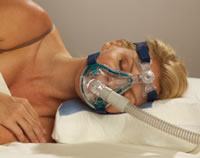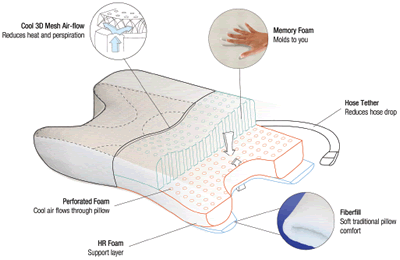Product Premiere
Reinventing the Pillow
Contour Products new CPAPmax seeks to bring an end to the war between masks and pillows that can leave many CPAP patients lying awake at night.
- By David Kopf
- Nov 01, 2010
Ensuring a safe, sound and healthy night’s sleep for patients with obstructive sleep apnea is the ultimate goal of CPAP therapy, but what happens when the device itself is making it hard for the patient to get a good night’s sleep?

The CPAPmax makes enough room to let them move from back to side throughout the night without dislodging their masks.
That was the exact question Contour Products had when it was developing its CPAPmax pillow, says Scott Davis, the president of Contour Products. Often at night patients’ CPAP masks and pillows are at war with each other. If the patient moves form side to side, the pillow can push the side of the mask and dislodge it from proper position.
Or, a little bit of pressure can cause a small leak around the seal so that the mask won’t work right. This can cause the pumps to respond by pushing more air in, and the leak can also make a noise from the escaping air that can disturb the patient. In fact, these pillow-PAP battles don’t even need to happen to keep patients awake at night.
“Patients actually become anxious about that happening during the night,” Davis says. “So they will wake up and make sure their mask is properly positioned and then go back to sleep, and then wake themselves up and do it again. They’re worried about the mask not being seated properly.”
Also, users tend to overcompensate for these sorts of distractions (or potential distractions) by overtightening their masks, which makes them more uncomfortable to wear and leave an undesirable imprint of the seal on their face in the morning. It’s a no-win situation.
So, Contour set out to reinvent the CPAP pillow. While Contour has developed pillows and cushions for CPAP users, the goal was to take CPAP pillows to a completely new level.
“We started over from scratch,” Davis says. “We took the information we received from users, respiratory therapists, and practitioners in the field and applied those things.”
The goal was to make the most functional for CPAP users in terms of providing head support, proper airway alignment, improved width of head support and postural aspects, and better nose clearance for not just the nose and face area, but the forehead, as well, says Davis, an industrial engineer by trade.
“Some of the brands of masks have larger forehead stabilizers that can interfere with part of the pillow,” he says. “So we made the area that accommodates the mask much wider.”
The pillow also lets users sleep on their backs or their sides. Many patients are both back and side sleepers and the pillow needs to provide enough room to let them transition from back to side without having to do any sort of adjusting, Davis says.
“Those two positions require different approaches to alignment and support,” he says. “When someone is on their back, you want the occipital [very back] area of the head to drop down a little lower so you have more elevation in the trachea so you have more alignment in the airway. When you’re on your side you want consistent lateral support so you’re in consistent alignment with your spine. So it’s a little different approach between the back and the side sleeping positions.”
Besides the shape, the pillows are more breathable. This is important because many flow generators supply warm, humidified air, which prevents the patient from drying out, but it also can make patients warmer. So, the pillow is ventilated throughout with two sides: one with memory foam, and one with conventional foam. The memory foam layer has an outer layer of “spacer fabric” that lets air circulate under the user’s head to prevent any buildup of heat or humidity. The conventional foam layer has a fiber-filled layer on top to keep things equally cool.
Ultimately, the distractions and discomfort that result from poor pillow-CPAP fits are part of the reason why sleep patients suffer high non-compliance rates, Davis says. So, as seemingly innocuous as they are, pillows are critical. Bottom line: comfort equals compliance.
“If you don’t have the proper pillow, it can make the device more uncomfortable, more awkward and cumbersome,” he says. “The end result is that patients don’t adhere to their therapy.”

Both the memory foam and fiber filled sides of the dual sided CPAPmax
help keep patients cool at night, regardless of any warm, humidified air
coming from a CPAP’s flow generator.
CPAPmax
Contour Products Inc.
www.contourliving.com
(800) 950-0230
This article originally appeared in the November 2010 issue of HME Business.
About the Author
David Kopf is the Publisher HME Business, DME Pharmacy and Mobility Management magazines. He was Executive Editor of HME Business and DME Pharmacy from 2008 to 2023. Follow him on LinkedIn at linkedin.com/in/dkopf/ and on Twitter at @postacutenews.